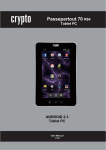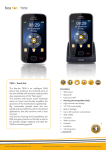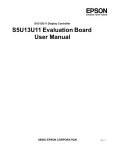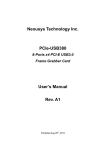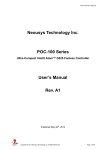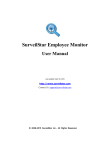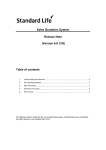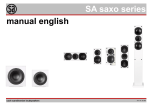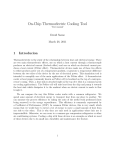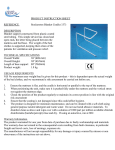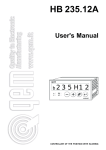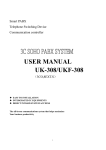Download KP Typing Tutor International Generation Version 4.11 Copyright (C
Transcript
KP Typing Tutor International Generation Version 4.11 Copyright (C) 1994-1997 Zijian Huang All Right Reserved Freeware Note: KP Typing Tutor 4.1 and previous versions are released as shareware. 1997, this software is released freeware. Since the end of KP Typing Tutor International Generation 4.11 with virtual keybaord and palms supports most of the keyboard templates and alphabet languages, supports the Dvorak keybords as well; flexible and alternatives courses provides more free choices to users of various characteristics and experience; KP encourage you learn to type as soon as possible, shorten your total learning time as much as possible. MAIN CONTENT: (In file "readme.txt") * Requirement * Install and Run * Introducion to Functions * Suggestion to Learner * Distribution * Learning to Type * Suggestion to Teachers * Suggestion to Network Managers (In file "readme2.txt") * How the batch files work * Where to get a most original copy of KP * How to modify or produce a keyboard template file * Turn to the Dvorak keyboard If you want to turn to the Dvorak keyboard typing style, please also read the file "dvorak.txt" with this sfotware. -----------------------------------------------------------------------------REQUIREMENT The KP requires the following minimum equipment to run properly: * IBM PC, XT, PS/2, 80X86, or IBM compatible * MS-DOS Compatible - All versions from 3.0 and up * 640 KB memory * Monitor (Mono, EGA/VGA) ------------------------------------------------------------------------------ INSTALL and RUN KP file list abstract: ===================== *.exe *.rec *.txt *.bat *.key KP file list and description: ============================ kpworldg.exe The running program kp.rec The user record readme.txt User manual (This file) readme2.txt Some technical details of KP useful to teachers and network managers dvorak.txt Introduction of the Dvorak keyboards kpuk.bat Batch file to start KP, using UK keyboard template kpukf.bat using an alternative keyboard template for UK keyboard kpukm.bat using mono mode in mono monitor kpus.bat for US keyboard kpusf.bat using alternative keybaord template for US keyboard kpdvorak.bat for Dvorak keyboard, with Dvorak course kpdvoraf.bat using alternative keyboard template uk.key keyboard template for UK keyboard, a text file ukf.key an alternative keyboard template for UK, different colors us.key for US keyboard usf.key an alternative keyboard template for US, different colors dvorak.key for Dvorak keyboard dvorakf.key alternative keyboard template for Dvorak keyboard kp.txt Text file for skilful practice kpcourse.txt Course file for the QWERTY keyboard coursed.txt Course file for the Dvorak keyboard kpgame.txt Data strings for the KP game NOTICE: New keyboard template files and course files supporting other keyboard templates and alphabetic languages may be added later without advance notice. Please check any KP typing tutor WWW page or contact the author for further information. You may select your favourite course for practice, by modifying a batch file. Other text files can be used as sample source files. For more details, please see the document "readme2.txt". It is recommended that you run KP via a batch file. In Ms-Win, you can just double-click the icon of a "*.bat" file to make it run. -----------------------------------------------------------------------------INTRODUCTION TO FUNCTIONS The functions of KP are divided into six parts: 1. Course 2. Letter Practice 3. Sentence Practice 4. Text Practice 5. File 6. Game 7. Help 0. Exit You can type the appropriate number or initial capital letter to select a function. YOU DON'T HAVE TO FOLLOW THE ORDER OF THESE FUNCTIONS TO PRACTISE. 1. Course ========= This function is for beginners who like to be guided to practise step by step from the very beginning. To train yourself for good manner of typing, just look at the sample, try not to look at the prompt of the virtual keyboard and palms, never look at the keyboard. 2. Letter ========= This function is for users who are in beginner level and want to practise a few letters first. You can input what you want to practise and then practise. When you input a character string as a sample, the character that you input and the virtual finger that you should use will blink. You may use the Backspace key to modify. After you press Enter, the string will be repeated several times to fill a line shown on the screen as a sample. Then you can type characters following the sample. For example: You input "afet koe"; then the screen will show "afet koe afet koe afet koe afet koe afet koe ..." 3. Sentence =========== This function is for users who are familiar with most of the key locations and want to practise more skilfully. 4. Text ======= This function is for those who know all the key locations and want to type faster or test their speed with a long article, simulating the real office typing environment. The program will ask you to indicate how many (like 5, 15, 218) lines you want to practise. After you input a number, several lines of text will be shown on the upper part of the screen, the cursor will be on the lower part waiting you to type. Within a line, you can delete. When you finish all the lines selected, the speed and accurate rate will be shown. You can press Enter to terminate input of the current line and go to next line, but the letters left behind are regarded to be typed incorrectly. You can also press Esc to go back to main menu. This function combined with function 4 can also be useful for competition of typing. For more detail, please read the document "readme2.txt". If you select too many lines out of the total lines of the text file, then the whole text file will be used. 5. File. ======== You can re-define a text file as source of sample text. This function will change the text sample source used by function "Sentence Practice" and "Text Practice". You may use this function to select texts of your favouriate subject to practise. In function "Text Practice", if you select too many lines out of the total lines of the text file, then the whole text file will be used. Function "File" combined with function "Text Practice" can also useful for competition of typing. -----------------------------------------------------------------------------SUGGESTION TO LEARNER 1. Use all your fingers to type. With your fingers curved and positioned upright, place your fingers on the home keys "A S D F J K L ;"; Place your thumbs slightly above the space bar. You may easily return your fingers to the home keys by the index fingers detecting the 'F' and 'J' keys. 2. Hit the keys with your tips gently; Use one of your thumbs to press the space bar; Use your right little finger to press Enter, then return the finger to the typing position. Though the little fingers are shorter, you make sure the little fingers touch the home keys. 3. To type a upper case character, press Shift with the little finger of one hand, while it is fully pressed, strike the letter key using a finger of the other hand, then release the Shift key. 4. Always make your fingers are on the home keys after striking keys out of home. 5. Never look at the keyboard. Try your best not to look at the virtual keyboard and palms, unless you forget the key location or which finger should be used. * Any time you can press the Esc key to go back to the previous status. * When you press the first character in practice, the stopwatch starts to run, until you accomplish the practice and strike one more key. * You may use the Backspace to delete. But this is not recommended in the very beginning. * You can learn to type within 12 hours in one week, or 16 hours in two weeks, or 22 hours in three weeks. * Take it easy and learn it easy. You can teach yourself in the way you like. Several Mistakes Many beginner might make in the very beginning: 1. Always forget the return fingers to the home keys; 2. The little fingers always hang in the air without touching the 'A' and ';' keys. 3. Forget to make the fingers be curved; 4. Can not resist the temptation to look at the keyboard; 5. Too eager to type faster, don't care about the accuracy ---------------------------------------------------------------------------- LEARNING TO TYPE What is the standard for learning to type? * At least, you can type A-Z using at least nine of your fingers without looking at the keyboard. * Or you can type a sentence at a speed of 60 keystroke per minute, or 15 WPM. * Or you can type as fast as you write. * Or you can type at a speed of more than 240 keys per minute or 40 WPM. ... My opinion is that A-Z is enough for a beginner, other symbols can be neglected in the beginning. -----------------------------------------------------------------------------SUGGESTION TO TEACHERS It is possible and recommended to change the content of practice according to your flavour and the situation of your students. You may produce your own text files as samples to be sued by KP. KP provides two keyboard template styles each for the UK keyboard and the US keyboard. If you want to modify the color of the keyboard template, please refer to document "readme2.txt". You may get some ideas if you compare the running of 'kpus.bat' and "kpusf.bat", then compare "us.key" and "usf.key", and then read "readme2.txt". -----------------------------------------------------------------------------SUGGESTION TO NETWORK MANAGERS If you happen to be a network manager of a windows environment, you might produce several program icons to start various "*.bat" files that indicate various practice styles. Please notice that MS-Window contain a Dvorak keyboard driver, you must install it previously. Some vendors also provides the Dvorak keyboard driver for DOS environment. Please also read "How the batch files work" in file "readme2.txt" -----------------------------------------------------------------------------!!!!!!!!!!!!!!!!!!!!!!!!!!!!!!!!!!!!!!!!!!!!!!!!!!!!!!!!!!!!!!!!!!!! Declaimer This software is provided to you AS IS without warranty of any kind, either expressed or implied. Zijian Huang does not warrant that the functions contained in this program meet your requirements or work uninterrupted or error free. In no event will Zijian Huang be liable to you or any third party for any damages, including any loss of profit, lost savings or other incidental, consequential or special damage. In addition, the files listed above should not be removed. Any work by others who extend the KP should be recorded in a file named 'Coother.txt'. You are very welcome to redistribute KP if all the files listed in document "readme.txt" are included and without involving commercial benefit and any modification. All the files of this software are recommanded to be packaged in a compressed file like "kpmost.zip". The distribution that involve commercial benefit should follow the terms of the copyright note and the licence agreements of KP Typing Tutor International Generation. !!!!!!!!!!!!!!!!!!!!!!!!!!!!!!!!!!!!!!!!!!!!!!!!!!!!!!!!!!!!!!!!!!!!! Wish you learn to type soon. Zijian Huang E-mail: www: [email protected] http://www.sti.gd.cn/personal/zjhuang/ Note: From Dec, 1997, the KP Typing Tutor 4.11 will be distributed as freeware. Those who happen to use the previous versions distributed as shareware may use KP free of charge. KP 4.11 is nearly the same as KP 4.1 with only copyright message changed. By the time the KP for Win and JAVA are accomplished, the source codes of KP 4.11 will be available to those who want to learn C++ programming.











